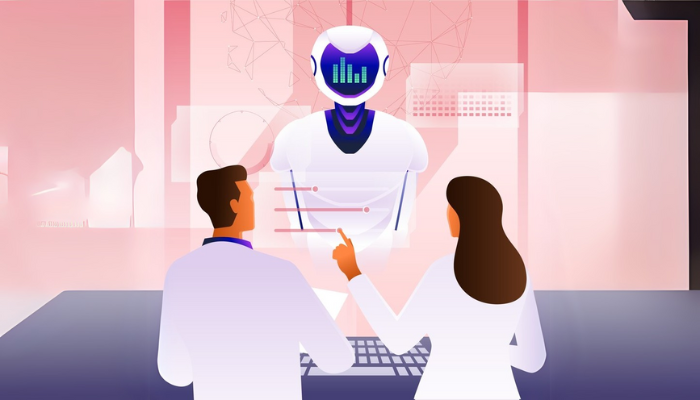Agentic Process Automation (APA) is changing the way businesses approach automation. While traditional automation relies on human input at every step, APA uses AI agents to take over complex tasks and make decisions independently. This allows businesses to cut down on repetitive work and gives teams more time to focus on high-priority tasks.
For instance, businesses implementing APA have been able to automate everything from data analysis to customer service, all while improving decision-making in real-time. Research shows that companies using AI-driven automation see productivity gains of up to 66% in their first year.
In this guide, we’ll walk you through how APA works, the key benefits it offers, and why it’s a valuable tool for businesses looking to improve efficiency and reduce costs.
In this guide, we’ll cover:
- A clear definition and understanding of APA.
- How AI agents autonomously execute tasks and make decisions.
- Why APA is an effective solution for increasing efficiency and cutting costs.
- What you need to consider when adopting APA in your business.
- Examples of businesses that have successfully integrated APA.
- What’s next for AI-driven automation and how it will impact your industry?
What is Agentic Process Automation (APA)?
Imagine having a system that doesn’t just follow instructions, but makes decisions and adjusts in real-time—without you having to lift a finger. That’s what Agentic Process Automation (APA) does. It’s a major upgrade from traditional automation.
Instead of relying on pre-set rules and human intervention, APA uses AI agents to handle complex, multi-step tasks all on their own. These agents can make decisions, learn from patterns, and even adapt to changing conditions in your business. They’re not just executing tasks—they’re managing processes from start to finish, and getting smarter as they go.
For example, instead of manually tracking customer orders or responding to simple queries, an AI agent can analyze customer data, predict behavior, and automatically trigger actions—whether it’s sending a follow-up email or adjusting an order. This kind of automation removes the bottlenecks caused by human oversight and streamlines workflows.
Want to learn about the different types of Agentic AI and how they differ?
Check out our blog on [Types of Agentic AI]
It’s important to understand the core technologies that make Agentic Process Automation (APA) so powerful. These are the building blocks that allow AI agents to perform tasks independently, make real-time decisions, and continuously improve.
Core Technologies of APA
Let’s take a closer look at the technologies driving APA and how they work together to create smarter, more efficient systems.
1. Artificial Intelligence (AI)
AI is the heart of APA. It gives AI agents the ability to learn, reason, and make decisions without human intervention. Through machine learning algorithms, AI agents can process vast amounts of data, detect patterns, and improve their performance over time. This makes AI ideal for handling complex, dynamic tasks that require constant adaptation.
- Machine Learning: Enables AI agents to learn from past data, predict future outcomes, and make smarter decisions.
- Deep Learning: A subset of machine learning that processes data through artificial neural networks, allowing AI to perform tasks like image and speech recognition, and even more complex decision-making.
AI & ML, But Make It Work for You.
We craft AI and ML solutions that actually move the needle for your business.
Drop us a message, and let’s get started!
2. Natural Language Processing (NLP)
Natural Language Processing (NLP) allows AI agents to understand, interpret, and generate human language. With NLP, APA systems can handle tasks such as answering customer queries, processing emails, and analyzing customer feedback.
- Sentiment Analysis: Used in customer service and marketing, NLP enables AI agents to analyze emotions behind words, helping businesses understand customer satisfaction or dissatisfaction.
- Text Classification and Generation: AI agents can classify text data and even generate content, such as email responses or chat interactions, all while sounding natural and human-like.
3. Robotic Process Automation (RPA)
RPA focuses on automating repetitive, rule-based tasks, such as data entry, report generation, or transaction processing. In APA, RPA is integrated with AI, allowing for a seamless workflow where simple tasks are automated, and more complex tasks can be handled by intelligent AI agents.
- Task Automation: While traditional RPA is limited to predefined tasks, APA’s RPA component can adapt based on decision-making, creating more flexible workflows.
- Cross-Platform Integration: APA with RPA can integrate with various platforms, from CRM to ERP, ensuring that data is automatically pulled and processed across systems.
4. Generative AI
Generative AI is a key technology in APA that enables AI agents to generate new content, solutions, or decisions based on their learned knowledge. This goes beyond task automation and into areas like content creation, decision-making, and even innovation.
- Content Creation: AI agents can generate marketing materials, reports, or customer communications, based on data analysis and trends.
- Decision-Making Models: Generative AI can simulate various decision paths and outcomes, helping businesses make informed choices quickly.
5. Cloud Computing
Cloud computing plays a crucial role in APA by providing the scalability and flexibility that AI agents need to perform across different environments. With cloud-based infrastructure, businesses can deploy AI agents quickly, without investing heavily in physical infrastructure.
- Scalability: Cloud computing allows businesses to scale their APA systems based on demand. This means they can handle spikes in data processing or task execution without downtime.
- Data Storage and Accessibility: Cloud services provide easy access to large datasets, allowing AI agents to quickly process and analyze data in real-time.
Each technology plays a vital role in helping AI agents operate autonomously and adapt to changing needs.
Also Read: Understanding Benefits and Challenges of AI in Cloud Computing
Now that we’ve covered what Agentic Process Automation (APA) is and the core technologies behind it, let’s take a moment to compare APA with Robotic Process Automation (RPA)—a technology that has been around for years but is often confused with APA. While both aim to automate business processes, they operate in fundamentally different ways.
Comparison between APA Vs RPA
While both Agentic Process Automation (APA) and Robotic Process Automation (RPA) focus on automating business processes, their capabilities differ significantly. Here’s a clearer comparison of how they stand apart:
| Aspect | Agentic Process Automation (APA) | Robotic Process Automation (RPA) |
| Automation Scope | Automates complex, multi-step processes, including decision-making. | Automates simple, repetitive tasks with no decision-making ability. |
| Technology | Uses AI, machine learning, NLP, and RPA to make intelligent decisions. | Relies on predefined scripts and workflows without any learning. |
| Decision-Making | Makes real-time, data-driven decisions and adapts to changing circumstances. | Follows rigid, predefined rules with no decision-making capability. |
| Adaptability | Can adapt to new situations and continuously improve over time. | Limited adaptability; tasks must be reprogrammed manually for changes. |
| Task Complexity | Handles both simple and complex tasks, including data analysis and customer interactions. | Primarily focuses on simple, rule-based tasks like data entry and form processing. |
| Integration Flexibility | Easily integrates with other AI technologies and systems to create a seamless workflow. | Works with existing systems but lacks deep AI integration for dynamic tasks. |
| Learning & Improvement | Continuously learns from data, improving its efficiency over time. | Does not learn; processes remain static unless manually updated. |
| Human Intervention | Requires minimal human intervention once set up. | Often requires human oversight or intervention for non-standard tasks. |
| Best Use Cases | Complex decision-making, customer service, marketing automation, and data analysis. | Simple tasks like data entry, invoice processing, and basic customer service queries. |
Curious about the tools behind these technologies?
Check out our blog on [The Best Agentic AI Frameworks and Tools] for more.
Now that we’ve compared Agentic Process Automation (APA) to Robotic Process Automation (RPA), it’s time to explore how APA works.
How APA Works
Agentic Process Automation (APA) isn’t your typical automation system. It’s a blend of AI agents and machine learning that can autonomously execute complex tasks, make decisions, and continuously improve. Here’s how it works:
1. AI Agents at the Core
At the heart of APA are AI agents—think of them as highly specialized digital employees. These agents aren’t limited to simple tasks; they can handle multiple, interdependent activities, from processing orders to analyzing data, and even responding to customer inquiries.
2. Decision-Making in Real-Time
APA takes things a step further by adding decision-making capability. Using AI and machine learning, these agents can analyze data on the fly and make decisions based on patterns they’ve learned. So, instead of following a set of rigid instructions, the AI agents are adapting to new information as they go—just like a human would.
3. Continuous Improvement
What makes APA truly powerful is its ability to learn and optimize over time. Every time an AI agent completes a task, it gathers insights from the outcome, making adjustments for better results in the future. This means that, as it operates, APA is getting smarter and more efficient, optimizing processes without needing you to do anything.
4. End-to-End Process Management
APA doesn’t stop at automating tasks—it handles entire workflows, from start to finish. Whether it’s pulling data from your CRM, processing an order, or sending follow-up emails, APA manages everything, without needing your team to intervene at any point.
Key Benefits of Agentic Process Automation
Agentic Process Automation (APA) isn’t just about replacing manual tasks; it brings real, measurable benefits to businesses. Here’s why more companies are turning to APA:
1. Increased Efficiency
APA drastically reduces the time spent on repetitive tasks. By automating end-to-end processes, it allows businesses to operate faster and with fewer delays. Whether it’s managing data, processing transactions, or responding to customer inquiries, APA speeds up operations, letting your team focus on more strategic work.
2. Cost Savings
With APA, businesses reduce the need for manual labor. This doesn’t just mean fewer staff to handle repetitive tasks—it means reallocating resources to higher-value work, optimizing the way your business operates, and cutting down on human error. Over time, these savings add up.
3. Improved Decision-Making
APA’s AI agents don’t just follow instructions—they make decisions based on real-time data and patterns. This means your business can act on data as it’s happening, leading to better decision-making. Whether you’re adjusting marketing strategies or responding to customer feedback, APA ensures that your decisions are data-driven and timely.
4. Scalability
As your business grows, so does the demand for efficiency. APA scales easily, handling increasing amounts of data or tasks without needing to expand your team. AI agents adapt as your business evolves, managing more processes with the same level of accuracy and speed.
5. Consistency and Accuracy
Humans make mistakes, especially when handling repetitive tasks. APA eliminates this risk by ensuring that processes are executed with precision every time. Whether it’s data entry or customer follow-ups, the work is always consistent, reducing errors and improving the quality of output.
Challenges in Implementing APA
While Agentic Process Automation (APA) offers tremendous benefits, implementing it in your business comes with its own set of challenges. Here’s what to keep in mind as you consider adopting APA:
1. Integration with Existing Systems
One of the biggest hurdles businesses face is integrating APA with their existing systems—whether it’s your CRM, ERP, or customer service platforms. It’s essential that APA works seamlessly with your current software to avoid disruptions.
Solution: Work with experienced AI developers to ensure smooth integration. This way, APA can communicate and share data across your systems without issues, allowing for more streamlined operations.
2. Data Privacy and Security
Since APA often involves handling sensitive data, ensuring the security and privacy of that information is crucial. Businesses must comply with regulations such as GDPR or CCPA when dealing with personal data.
Solution: Implement strict security measures and choose APA solutions that are built with privacy in mind. Regular audits and monitoring can also help mitigate any risks related to data breaches.
3. Training and Adoption
For teams unfamiliar with AI and automation, getting employees onboard can be a challenge. There’s a fear that AI will replace jobs, or employees may resist new technology because it feels complicated.
Solution: To ease the transition, focus on AI as a tool to support and enhance human work, rather than replace it. Provide thorough training and highlight how APA can help employees focus on more impactful, creative tasks rather than manual, repetitive work.
4. Cost of Implementation
While APA promises long-term cost savings, the initial investment can be high. Building custom AI agents and implementing APA may require significant upfront costs, including software, training, and infrastructure.
Solution: Consider starting with smaller pilot projects that target specific areas of your business. As you see positive results, you can scale up gradually, making the initial investment more manageable.
Real-World Applications of APA
Now that we’ve covered how APA works and its benefits, let’s take a look at how it’s being used in the real world. Here are some practical examples of how businesses are leveraging APA to improve operations:
1. Customer Service Automation
Many companies are turning to APA to automate customer support. AI agents can handle everything from answering basic FAQs to managing support tickets and live chats. This not only reduces response times but also improves customer satisfaction by providing quick, accurate responses.
Example: A leading eCommerce platform uses APA to handle customer inquiries about product availability, order status, and returns, allowing their customer service team to focus on more complex issues. This has led to a 30% reduction in customer service costs.
2. Marketing Campaigns
APA is making waves in marketing by automating customer segmentation, personalized email campaigns, and social media engagement. AI agents can analyze customer behavior in real-time, adjust campaign strategies, and deliver personalized content based on user interactions.
Example: A global retail brand uses APA to personalize marketing emails, increasing open rates by 20% and significantly boosting conversion rates. The AI continuously adapts the email content based on user preferences and behaviors.
3. Data Analysis and Reporting
Data analysis is critical for businesses to make informed decisions, but it’s also time-consuming. With APA, businesses can automate data collection, analysis, and reporting. AI agents can sift through massive datasets, identify trends, and generate reports, freeing up employees to focus on strategic tasks.
Example: A financial services firm uses APA to automate financial reporting and predict market trends based on historical data. This allows their analysts to focus on developing actionable insights rather than manually gathering and processing data.
4. Supply Chain Management
APA is also streamlining supply chain management by automating inventory tracking, demand forecasting, and supplier communications. AI agents can predict inventory needs, ensure timely restocking, and even negotiate with suppliers, reducing the time spent on manual operations.
Example: A manufacturing company uses APA to automate order tracking and inventory management. The AI agents adjust supply chain operations based on demand forecasts, reducing stockouts by 15% and improving delivery times.
5. Human Resources and Recruitment
APA can streamline recruitment processes by automatically screening resumes, scheduling interviews, and even conducting initial candidate assessments. AI agents can analyze candidate data, compare it with job requirements, and shortlist the most qualified applicants—reducing time spent on manual screening and improving hiring efficiency.
Use Case Example: A global tech company has integrated APA into their recruitment process, where AI agents handle resume screening, interview scheduling, and even conduct preliminary assessments. This has cut down their hiring time by 40% while improving candidate selection accuracy.
These are just a few of the powerful ways businesses are using APA to drive efficiencies, reduce costs, and improve decision-making. As more industries adopt APA, the possibilities will continue to expand.
Interested in building your own Agentic AI systems?
Our [Beginner’s Guide to Building Agentic AI Systems in Python] has you covered.
While the applications of APA are clear, adopting it in your business requires careful consideration. Here are the key factors to keep in mind as you integrate AI agents into your operations.
What You Need to Consider When Adopting APA in Your Business
Adopting Agentic Process Automation (APA) can significantly enhance your business operations. However, before diving into implementation, it’s crucial to define a few key requirements to ensure smooth adoption and long-term success.
1. Clear Goals and Objectives
Start by identifying the specific business processes you want to automate. Whether it’s improving customer service, automating reporting, or optimizing internal workflows, knowing exactly what you want to achieve with APA will help you choose the right tools and set measurable KPIs.
2. Compatibility with Current Systems
Assess how well the APA solution will fit into your existing technology infrastructure. This includes ensuring that your CRM, ERP, and other platforms can seamlessly integrate with the new system. Understanding this will prevent any unnecessary disruptions during the implementation phase.
3. Data Management Requirements
Define how your business will handle data within the APA framework. Consider data privacy, compliance, and security measures. Ensure that your APA solution meets regulations like GDPR or CCPA, especially if you’re dealing with sensitive customer information.
4. Team Alignment and Training Needs
Make sure your team is ready for the shift to APA. Define the training needs and decide who will be responsible for managing the AI agents. Providing proper training and clear communication will help reduce resistance and maximize the system’s effectiveness.
5. Scalability and Flexibility
Think about how your needs will evolve over time. Choose an APA solution that can scale with your business growth and adapt to new business needs or expanded functionalities. This ensures you won’t need a complete overhaul as your company grows.
6. Budget and ROI Expectations
While APA can be an investment, define your budget and expected ROI. Understand the upfront costs and how automation will lead to long-term savings. Starting small with a pilot project can help you assess its impact before committing to a larger-scale implementation.
By now, you’ve seen how Agentic Process Automation (APA) can elevate your business by automating complex workflows, improving decision-making, and driving efficiency. But how do you get started with implementing APA in your business? That’s where Codewave comes in.
At Codewave, we specialize in developing custom AI agents that are tailored to meet the unique needs of your business.
Why Codewave for Agentic Process Automation?
At Codewave, we specialize in developing agentic AI systems by embedding Agentic Process Automation (APA) into our software development process. Here’s how we do it:
- Focus on Agentic AI: We build intelligent agents that can understand context, make autonomous decisions, and take multi-step actions—unlike traditional rule-based automation.
- APA Integration in Software Development: We integrate APA principles throughout our development lifecycle, enabling agents to interact with users, systems, and data in real time.
- Tools & Frameworks We Use:
- LangChain and AutoGen for building multi-agent workflows
- OpenAI GPT models for natural language understanding and reasoning
- Vector databases for long-term memory and contextual awareness
- API layers to connect agents with internal tools (e.g., CRMs, ERPs, EHRs)
- Modular, Scalable Architecture: Our agents are designed as modular, API-driven components that can scale with business needs and adapt to evolving workflows.
- Continuous Learning & Adaptation: The agents learn from interactions and outcomes, improving their performance over time—making automation smarter and more human-like.
Building on our expertise in Agentic Process Automation, Codewave designs and delivers domain-specific AI agents tailored to solve real-world problems across industries.
Here’s a snapshot of the intelligent agents we develop across key sectors:
- Retail: We develop personalized shopping assistants, dynamic pricing bots, and inventory management agents.
- Healthcare: We create diagnostic assistants, appointment scheduling bots, and patient monitoring agents.
- Finance: We develop fraud detection agents, algorithmic trading bots, and personalized financial advisors.
- Customer Service: We create 24/7 chatbot support, intelligent call routing agents, and personalized feedback analysis bots.
- Energy: We develop smart grid management agents, energy consumption optimization bots, and renewable energy forecasting agents.
- Education: We create personalized learning assistants, automated grading bots, and student engagement monitoring agents.
Ready to explore how AI agents can transform your business?
Schedule a consultation with us today and see how Codewave can help you leverage the power of APA for smarter, more efficient operations.
Codewave is a UX first design thinking & digital transformation services company, designing & engineering innovative mobile apps, cloud, & edge solutions.







